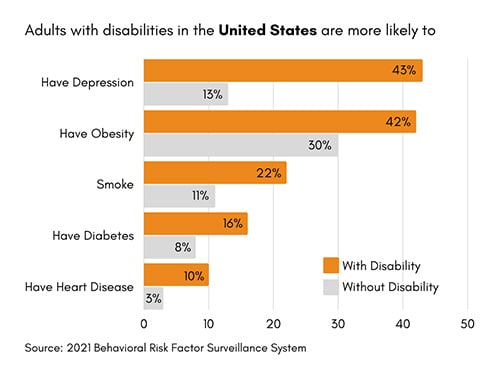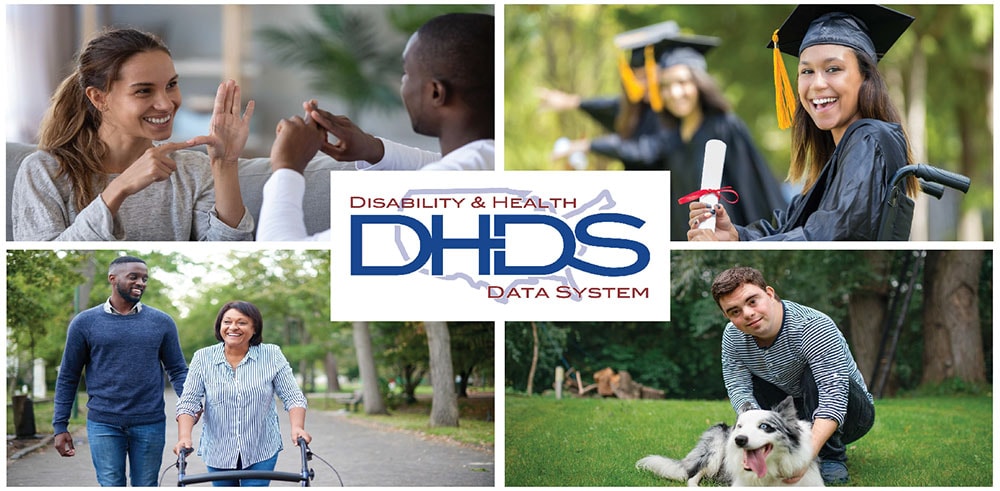CDC’s Disability and Health Data System (DHDS)
Download and print this page [PDF 901 KB, 2 pages]
There are important health differences between and without disabilities. Do you know what those in your state? DHDS can help that.
Adults with disabilities experience significant health disparities compared to adults without disabilities. To improve the health of this population, state epidemiologists, researchers and public health professionals need access to accurate and timely data to inform their state’s health promotion activities.
The U.S. Centers for Disease Control and Prevention (CDC) created Disability and Health Data System (DHDS) to provide quick and easy access to data on demographics and health information for adults with disabilities.
Use DHDS to help improve the health and well-being of adults with disabilities.
Get started now! Visit the DHDS website.
DHDS is
- Interactive – An online, easy-to-use data tool that provides state and national-level data on approximately 30 health topics for adults with disabilities.
- Customizable – You can explore data by indicator (e.g., health topic) or by location, then customize maps, charts, and tables, making it easy to view information for your state.
DHDS can help you answer questions, such as
- What is the percentage of adults with a disability in my state?
- How does this population vary by age, sex, and race/ ethnicity?
- How does my state compare with other states and the nation?
- How does the percentage of obesity, smoking, diabetes, or heart disease vary among people with select disability types?

Data Available in DHDS
DHDS includes analyzed data from 2016 to 2021 in the Behavioral Risk Factor Surveillance System (BRFSS) on:
Disability estimates
- †Disability status (any disability or no disability) and disability types (cognitive, mobility, vision, self-care, independent living, and hearing), overall health, and
- By age, sex, race/ethnicity, and veteran status.
Demographics among adults with and without disabilities and by disability types, including
- Income level;
- Education level;
- Marital status; and
- Employment status.
Approximately 30 health topics among adults with and without disabilities and by disability types, including
- Smoking;
- Obesity;
- Heart disease;
- Diabetes;
- Binge drinking;
- Flu vaccine; and
- Healthcare coverage.
CDC’s Partners and State Programs are Using DHDS
The Kansas Disability and Health Program works to teach the public about health differences faced by Kansans with disabilities. They have distributed more than 400 copies of CDC’s Kansas-specific Disability Impacts All of Us state profile, which includes data from DHDS, and shared it with 200 family physicians.
“I personally use the DHDS system to pull data not only for our Disability and Health Program, but also for classes I teach.”
Jean Hall – Director, Kansas Disability and Health Program
You Can Use DHDS to:
- Identify health differences between adults with and without disabilities overall and by age, sex, and race/ethnicity;
- Download data for use in presentations, reports, or fact sheets; and
- Inform partners, policymakers, and communities about the health of adults with select functional disability types.
About CDC’s Disability and Health Promotion Branch
CDC’s Disability and Health Promotion Branch promotes the health and full participation in society of people with disabilities across the lifespan. The Branch provides funding, technical assistance, surveillance, and ongoing scientific support to promote health equity, prevent chronic disease, and increase the quality of life for people with disabilities. For more information, visit the Disability and Health Promotion website.
† Respondents were defined as having any disability if they reported serious difficulty concentrating, remembering or making decisions (cognitive disability); serious difficulty hearing or deafness (hearing disability), serious difficulty walking or climbing stairs (mobility disability); serious difficulty seeing or blindness (vision disability); difficulty dressing or bathing (self-care disability); or difficulty doing errands alone (independent living disability).

